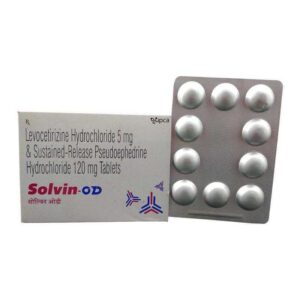PARACETAMOL (ACETAMENOPHEN) + BROMHEXINE
Paracetamol (acetamenophen): Paracetamol, also known as acetaminophen, is a commonly used medication for the management of pain and fever. It is available over-the-counter and can be found in various products, such as tablets, capsules, syrup, and as an ingredient in combination medications.
Paracetamol works by inhibiting the production of prostaglandins, which are chemicals that contribute to inflammation and pain in the body. It primarily acts in the central nervous system to relieve pain and reduce fever. Unlike nonsteroidal anti-inflammatory drugs (NSAIDs), such as ibuprofen, paracetamol has little to no anti-inflammatory effects.
The usual recommended dose of paracetamol for adults is 500 mg to 1000 mg every 4 to 6 hours as needed, not exceeding 4000 mg (4 grams) in a 24-hour period. For children, the dose is based on their weight and age, with proper guidance from a healthcare provider.
Paracetamol is commonly used to relieve mild to moderate pain, such as headaches, toothaches, muscle aches, and menstrual cramps. It is also effective in reducing fever associated with colds, flu, and other viral or bacterial infections.
While paracetamol is generally safe and well-tolerated when used as directed, it can have side effects in certain situations. These side effects are usually rare but can include allergic reactions, skin rashes, and liver damage in cases of overdose or when used excessively. It is important to follow the recommended dosage and seek medical advice if you have any concerns or experience unusual symptoms.
It is worth noting that paracetamol is often combined with other medications, such as opioids or antihistamines, in certain products. It is essential to read the labels and check for duplicate ingredients to avoid unintentional overdose. As always, it is best to consult a healthcare professional before starting any new medication or combination therapy.
Bromhexine: Bromhexine is a medication primarily used for the treatment of respiratory conditions that involve excessive mucus production, such as bronchitis, asthma, and chronic obstructive pulmonary disease (COPD). It is available in various forms, including tablets, syrups, and inhalation solutions.
The main mechanism of action of Bromhexine is to facilitate the breakdown and thinning of mucus in the airways. It does this by increasing the secretion of watery mucus in the respiratory tract, which helps to loosen and mobilize phlegm, making it easier to cough up and clear the airways.
The recommended dosage of Bromhexine may vary depending on the formulation and the specific condition being treated. In general, for adults and children over 12 years old, the typical dose is 8-16 mg three times a day. For children aged 6-12 years, the dose is usually 4-8 mg three times a day, and for children aged 2-6 years, the dose is 2-4 mg three times a day.
While Bromhexine is generally well-tolerated, some individuals may experience side effects. Common side effects include gastrointestinal symptoms like nausea, vomiting, diarrhea, and abdominal pain. Rarely, allergic reactions or skin rashes may occur. If any of these side effects occur, it is important to consult a healthcare professional.
It is also worth noting that Bromhexine may interact with other medications, so it is essential to inform the healthcare provider of any other drugs being taken before starting Bromhexine. Additionally, Bromhexine should not be used in patients with a history of gastric ulcers or liver disease without consulting a healthcare professional first.
In summary, Bromhexine is a medication used for respiratory conditions involving excessive mucus production. It works by thinning and loosening mucus, making it easier to cough up. The recommended dose varies based on the formulation and age of the patient. Common side effects may include gastrointestinal symptoms, and it may interact with other medications.

